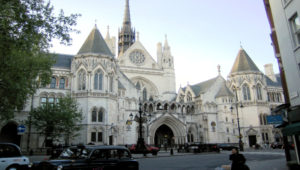
For those who have been following my family property trust’s long-running legal battle with Bank of Scotland and its LPA Receivers over the past seven years [those who haven’t can read about it here], the direction of our case has taken a conversely unsurprising but unexpected turn, just when our adversaries thought we were finally dead and buried, after the dismissal of our recent appeal of the Property Chamber’s decision to overrule our objection to the illegal fire-sale of a property called Ashquorn House in North Shields.
From the beginning of the dispute in June 2010, we have argued the following points of law in various high courts and property tribunals:
- There is not one legally valid and enforceable mortgage deed over any of the properties originally held in the trust’s portfolio.
- There is no mortgage contract that is signed by both the mortgagor and the mortgagee, containing all the terms and conditions the bank is seeking to enforce.
- There is no evidence that the trustees owe the bank the £2.5M it claims was outstanding at the beginning of the dispute in June 2010.
Since sections 1 and 2 pf the Law of Property (Miscellaneous Provisions) Act 1989 prescribe that no mortgage is created without a valid deed and bilateral contract, we have primarily focused upon proving those elements of our case, which eventually led to our historic summary judgment in the high court on the 21st of July 2014, when HHJ Behrens reluctantly admitted that section 2 applies to mortgage contracts and was forced to concede The Section 1(3) Point:
A mortgage deed will be illegal and void under section 52(1) of the Law of Property Act 1925, for failing to comply with section 1(3) of the 1989 Act, if the signature of the mortgagor is not properly attested to by an independent witness at the moment of execution – Bank of Scotland plc v Waugh & Others [2014].
This inevitably led to the success of our AP1 application to the Land Registry, originally made in February 2013, to cancel the entry of the illegal mortgage over Ashquorn House [along with thirteen other void mortgages] in the Charges Register; which should have opened the floodgates to millions of other claims on almost identical grounds, having created a legal precedent that is binding on all mortgage-related proceedings.
However, on the basis that Judge Behrens also ruled in the same judgment that the bank was still entitled to claim £1.8M from the trustees, having already received £700,000 in rental income and proceeds from property sales by July 2014; he then declared that the bank was entitled to a new mortgage over Ashquorn House because the debt hadn’t been settled and another entirely fraudulent deed was illegally registered, as a direct result.
For the last three years we have been engaged in a battle with the Land Registry and the Property Chamber to cancel the registration of the ‘new’ void mortgage, on the grounds that the deed was signed by a retired trustee and a district judge, after the current trustees refused to execute it; and because the document is an amended version of the void deed that was cancelled by the Land Registry, when it is well-established at law that a void deed is incapable of taking legal effect by way of amendment.
The only reason our most recent applications have been refused, therefore, is because Behrens ruled that the bank was still entitled to mortgages over all the trust’s properties, unless and until the allegedly outstanding debt of £1.8M is ‘repaid’ to the bank.
He also inexplicably declared that the original void deed still stands as a contract which complies with section 2 of the 1989 Act, on the ground that it is signed by both parties, despite the indisputable evidence before the court that the purported mortgage contract relied upon by the bank was a Facility Letter dated 27/07/2007, which was signed by the trustees but not by the bank.

When it appeared that we were banging our heads against the walls of the high court and the Property Chamber, after everything was dismissed as totally without merit for the same reason, it occurred to me that we needed to refocus on the issue of how much money would be due to the bank, in the event that the mortgages were held to be valid [even though they most certainly aren’t valid].
After trawling through all the trust’s bank statements and the accounts filed with HMRC during the seven years the arrangement with Bank of Scotland was running, it immediately became clear that the bank has been claiming compound interest on entirely fictitious mortgage arrears since 2003, as the trust’s verified accounts confirm:
Credit Used by the Trustees from 2003-2010 – £1.6M
Variable Interest Payable over 7yrs – £1M
Mortgage Money Claimable by the Bank – £2.6m
Sales, Deposits & Interest Payments by the Trustees – £2.25M
Balance Outstanding as of 21/06/2010 – £350K
Rental Income Received by LPA Receivers since 15/07/2010 – £450K
Interest Over-Payments by the Receivers as of 21/07/2014 – £100K
In simple terms, all the mortgages over the trust’s properties should have been discharged by the bank as of 21st of October 2013, which the receivers have no excuse for not knowing, as the purported managing agents of the properties, who owe the trustees at least £100K.
Instead of discharging the mortgages, around the same time, Bank of Scotland issued a high court claim for £1.8M, which was heard in Leeds by HHJ Behrens the following July, when he refused to listen to any submissions from the trustees as to the validity of the amount being claimed by the bank. Fraud upon the high court, by another name, as we have persistently argued.
Moreover, this also means that every one of the trustees’ AP1 applications to have all of the mortgages cancelled in the Charges Register, should have been granted by or before 21st of October 2013 by the Land Registry, in which case the bank’s claim would have been incapable of proceeding before Judge Behrens and nine properties would not have been fire-sold by the receivers, at an average of 35% of their true market value.
Given the unfolding of these extraordinary circumstances, I am naturally reminded of the following maxim pertaining to adversarial conflict, taken from The Art of War, by the immeasurably wise, Sun Tzu:
To fight and conquer in all your battles is not supreme excellence; supreme excellence consists in breaking the enemy’s resistance without fighting.
The protected beneficiaries of the rigged system cannot be beaten in armed conflict, but there is no denying that the only adversary who hasn’t already retreated from the legal battlefield is so weary of seeing us rise from the ashes of every miscarriage of justice we suffer, that they will ultimately lose the will to resist any actions we take; just as the solicitors of the bank and its receivers did when we won the section 1(3) point, before a judge who still did his best to shaft us.
Nevertheless, we identified in 2015 that the part of the system essential to perpetuating The Great British Mortgage Swindle was the Land Registry’s fatal presumption, under section 28(1) of the Land Registration Act 2002: that all mortgages are valid if they have been registered by the Land Registry, irrespective of their fatal legal defects.
The Chief Land Registrar is the last of our adversaries still standing on the battlefield, knowing full well that whoever retreats at this stage, loses by default; and that the Land Registry will be liable for the losses suffered by the trustees, in the event that our renewed AP1 applications are granted as of the day they were made in February 2013, on the ground that all of the mortgages should have been discharged nine months before the bank filed their high court claim for £1.8M in fictitious mortgage arrears.
For those who doubt the veracity of the allegation that the banks pretend to lend money created by the deposit of their customers’ promissory notes, I wholeheartedly recommend that you watch the lecture embedded below, by Professor Richard Werner, who is talking to a room full of chartered accountants about the mechanics of money creation.




